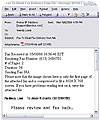Faxing: The HIPAA Risk That Hides in Plain Sight

Steve Adams is with MyFax, a provider of Internet faxing services for individual home users, small businesses and large corporations.
One of the most universal complaints women have about men is our inability to find objects that are right in front of us. We will go into the closet to look for a favorite pair of gloves, or into the refrigerator in search of a jar of olives, then start ranting and raving that someone (implied message: our significant other) has thrown them out or put them in the wrong place. At which point the significant other will walk up, grab whatever it is we’re looking for, look at us like the idiotic Neanderthals we are, and walk away.
Significant others typically end the hunt with a wisecrack along the lines of the object hiding in plain sight. The business world has its own version of this scenario with the facsimile. When it comes to the security of information required by the Health Insurance Portability and Accountability Act of 1996 (HIPAA), private information sent via fax could just be hiding in plain sight.
THE UNNOTICED RED FLAG
Most of the work that has been done to meet HIPAA requirements has focused on improving internal security protocols and encryption or other protection of email. The more stories came out about identity theft, information theft, stolen laptops, etc. the more resources were devoted to ensuring patient information was locked up tight. Faxing was largely ignored, because in our email-centric world faxing was considered obsolete, an archaic means of transmitting information, and therefore not really a HIPAA concern.Yet the reality of day-to-day healthcare operations is quite the opposite. Many providers still use handwritten charts; when those charts need to be transmitted to a consulting provider, an insurance company or even between offices, facsimile is the communication medium of choice. Insurance claims, prescriptions, patient histories, etc. are all likely to be faxed at one point or another

Despite the prevailing wisdom, faxing is still a critical component within the healthcare industry. An Internet-based fax service will allow confidential faxes to be sent via email. Recipients will receive an email alerting them of a fax, which will be included as an attachment, and can be saved in the email program.
THE FAXING TRUTH
The primary security risk in traditional, machine-based faxing is that it creates a very public view of very private documents. Consider what happens when a confidential document is sent from one organization to another via fax.First, the document is loaded into a fax machine located in a mailroom or other public are on the sender’s end, a phone number is dialed and the “send” button is pushed. If all goes well, the document is scanned and transmitted, and the sender takes the original document back to his/her desk.
If a busy signal is received, however, the sender may walk away for a few minutes while the machine continues to re-dial until it makes a connection. In the meantime, this confidential document is sitting exposed in a public area. This scenario is hardly in keeping with established best practices for document handling in a HIPAA-compliant organization.
On the other end, the things are even less compliant because the sender has no control over where the fax goes. While it might go to a gatekeeper’s desk, the more likely scenario is that it is received on a fax machine in a public area, where it sits until someone sees the cover page and delivers it to the rightful owner. In the meantime, anyone in the organization can walk by and read this confidential information, or even make a copy of it. If it is time-sensitive, there could be a significant delay until it is sorted and delivered; it could also be delivered to the wrong person, creating a further breach in security.
HIPAA-Compliant Faxing
There is a way, however, to bring faxing into HIPAA compliance: Internet faxing. With this technology, there are two confidential ways to send and receive faxes. One is via the user’s email account, where it is as secure as any other email. It is hidden from prying eyes unless the electronic fax is left on screen and someone else accesses the computer.The second method, sending and receiving via a secure server, offers even greater protection. Rather than delivering the actual fax, the secure server method sends an email notification alert to the user when a fax comes in to their account. Users then go to a password-protected site where the fax sits in a secure, encrypted in-box on a secure socket layer (SSL)-enabled server. This method allows for the documents to be protected by 128-bit encryption, 1024-bit public keys and PGP public key/private key security encryption.
SECURE SERVER FOR FAX
After logging in, users are able to view the fax and/or download it to their computer. This same method can be used in reverse to send a fax, leaving no trace of the original fax in an Outlook or other mail server “sent” file. The secure server method provides the ultimate in HIPAA-compliant security for the most sensitive documents.Operationally, Internet faxing appears the same as a traditional fax to the person on the other end. The Internet fax user has a telephone number, often toll-free, that can be called from any fax machine in the world. Faxes can be sent either to a standard fax machine or directly to the person on the other end if he/she also is using an Internet fax service.
Despite the prevailing wisdom, faxing is still a critical component within the healthcare industry. As such, information transmitted via fax runs the same risks of HIPAA violation.
Instead of allowing faxes to hide in plain sight, Internet fax services help security managers bring the fax portion of their operations up to the same standards used for other forms of communication. If HIPAA compliance falls under your purview, it should definitely be toward the top of the list.
SideBar: The Benefits of Internet Faxing:
- Elimination of paper faxes, reducing the risk of data being seen or copied by unauthorized personnel to almost nil.
- Elimination of the risk of a paper fax being inadvertently delivered to the wrong person or thrown away.
- Ability to store every fax electronically, either on the user’s PC or a password-protected network server, assuring there is always a copy of important information.
- Availability of 128-bit encryption and SSL when transmitting and receiving documents through the secure server method.
- Greater accessibility to the information when the fax owner is off-site.
- Easy integration with document management applications, eliminating the need to scan paper documents while making information more accessible to auditors and other authorized personnel.
Looking for a reprint of this article?
From high-res PDFs to custom plaques, order your copy today!



